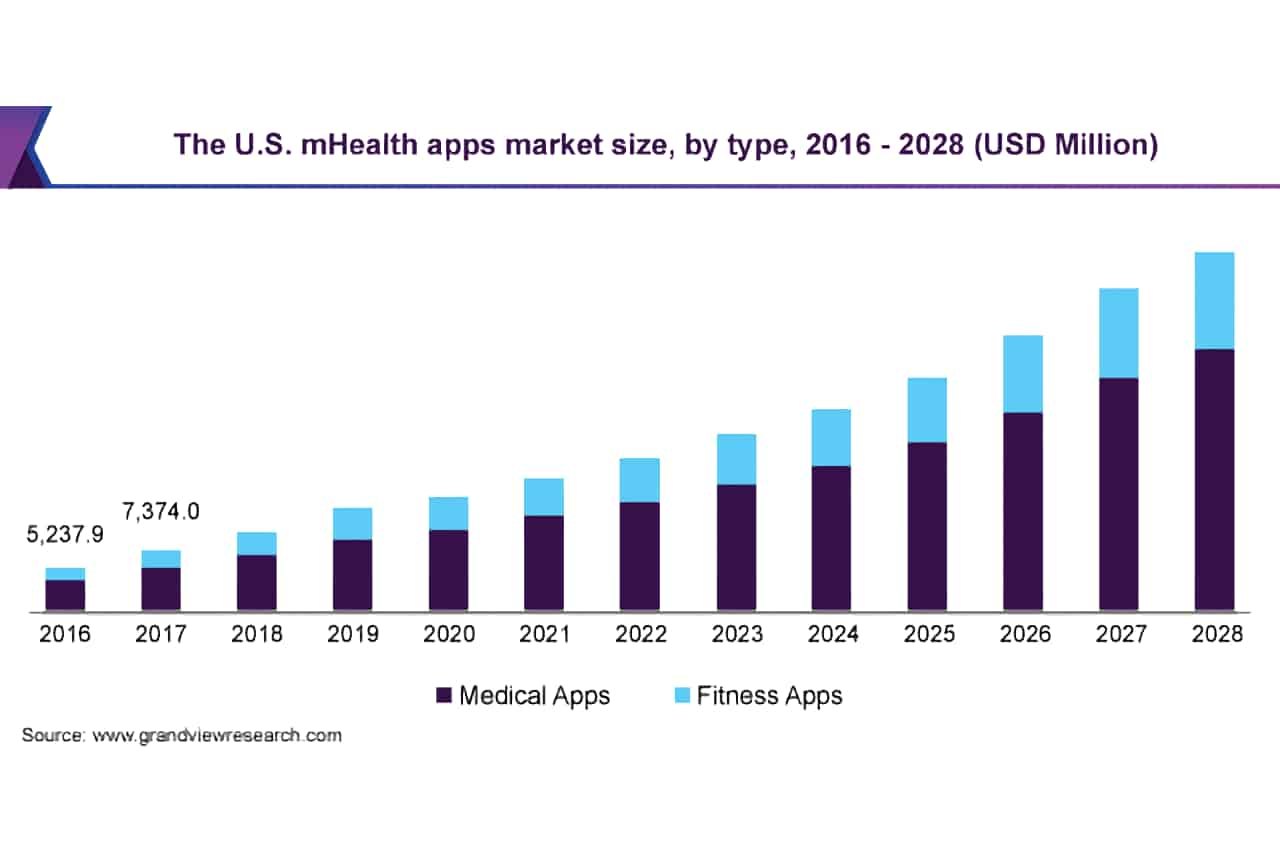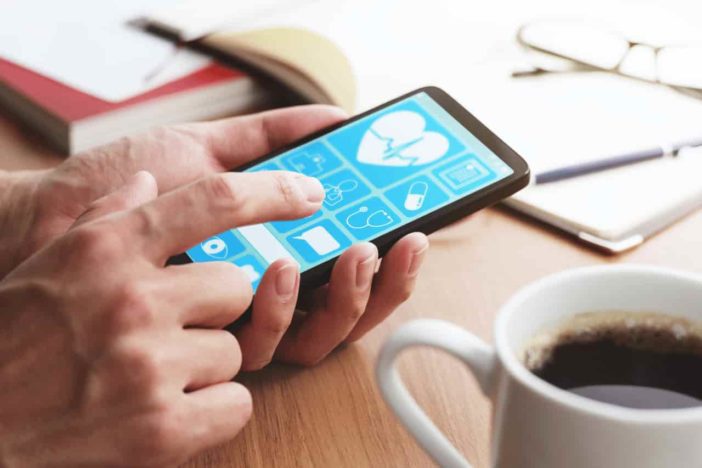Over the past 5 years, the use of mobile apps in healthcare has been growing. In 2018, users could choose from nearly 320,000 of these digital products, with almost 200 new options unveiled daily. The global pandemic is expected to spur this vigorous expansion. Businesses can capitalize on the latest surge in the provision of medical and public health services via mobile devices, such as smartphones, tablets, and wearables.
This segment, which is known as mHealth, is projected to reach $149.3 billion by 2028. Now is a great time to invest in mobile healthcare apps for doctors and patients. Discover the key challenges and benefits of this niche in our guide.

The Types of Apps in Healthcare and Their Features
According to the FDA (U.S. Food and Drug Administration), a healthcare app is a piece of mobile software that can diagnose, track, and treat diseases. However, the development category is wider, as it includes wellness apps that monitor overall health. All types of apps in healthcare may be divided into:
- professional apps, such as medical database apps, networking apps for doctors, and patient health tracking systems;
- apps for patients, such as medical education platforms, diagnostic apps, reminder apps, and dieting apps.
Many popular digital healthcare systems are packed with useful functions, and users of all ages can navigate them without effort. Discover the top features of medcare apps below.
Ease of Use
Patient apps must have a convenient and intuitive interface suitable for different age groups, as they are used by the elderly and young people with not much experience. Meanwhile, medical staff expect easy access to professional features and a well-designed layout, too. The simplicity of access is one of the biggest requirements for medical apps.
✋ Warning
🩺🏠 Your hard work deserves a reward! Explore special home loan programs designed for healthcare pros in this all-inclusive guide.
Cross-platform Accessibility
To maximize exposure, businesses must create solutions for both iOS and Android phones. Patients and doctors expect access to medical data from any popular device, either a smartphone or a tablet.
Offline Mode
The best systems can work without an internet connection. This is one of the top features of medcare apps, as it guarantees uninterrupted access. In this mode, data is collected regardless of connectivity, while backups are made continuously.
Monitoring & Analytics
Healthcare professionals use apps to view their patients’ data during checkups. It allows them to monitor progress at a glance, identify threats, and forecast complications. Instant access to analytics is one of the must-have benefits of using medical apps for staff.
Progress Tracking
Popular online medical apps track a range of relevant parameters depending on their purpose. These include blood pressure, heart rate, calorie count, diet, etc.
Easy Communication with Professionals
Patients who use apps to connect to doctors must be able to get updates from them instantly through their apps. Streamlined communication makes them feel looked after even outside of the hospital. This builds trust between the users and healthcare professionals.
Push Notifications
Users must also be provided with updates and reminders. The push format is essential, as it ensures instant visibility. Notifications pop up on mobile devices even when the apps are not open.
Appointment Scheduling
Apps that connect users to telemedicine staff or hospitals must offer clear and simple booking options. The opportunity to fix an appointment remotely is crucial. This warrants the integration of flexible scheduling.
Community Features
Aside from communicating with doctors, patients want to interact with each other. Integration of social platform features is recommended. It makes the digital ecosystem more welcoming and helps to reinforce healthy behaviors.
Payment Integration
Appointments and admissions require payment. Users must be provided with a range of convenient methods, such as major credit cards.
3rd Party Integrations
Depending on their functionality, some apps are linked to specific systems, such as Google Fit or Apple Health. Digital products that communicate with wearable devices, such as smart scales, must exchange data with them instantly.
Popular Healthcare Apps for Doctors and Patients
Take a look at some of the most popular healthcare apps in 2021. They offer diverse functionality, from medical reference to hospital booking to telemedicine visits. Here are eight inspiring examples.
Doctor on Demand — Convenient Telehealth
This application allows users to contact a doctor and schedule a visit 24/7. The system supports family use. As the name suggests, patients can get consultations from physicians via streaming video at $40 per session. This covers non-emergency issues, such as the flu, sunburn, or allergies. Doctors can issue prescriptions. The app also includes a lactation consultation and sessions with a psychologist.
Teladoc — 24/7 Access to a Doctor
This environment for on-demand telemedicine provides remote assistance for non-life-threatening conditions and injuries. Users can ask their questions via video chat or call, so they can avoid offline visits for minor issues.
Generis — Strong Focus on Community
Designed for patients with diabetes, this community-centered app connects them to other users in the area. When their supplies of test strips or glucose tabs run out, they can get help quickly. Users may also help each other with injections and blood tests. The system offers healthcare tips and food recommendations based on individual goals.
Epocrates — Medical Reference for Patients
Epocrates is a solution for users suffering from chronic disorders. Patients in need of regular consultations can connect to their physicians and get help. The system can identify unlabeled medications and check if particular drugs may be used together. Rich calculation tools and insurance coverage are other selling points.
Pepid — Connecting Patients and Pharmacists
This app connects users to pharmacists, helping them to get information about different medications, order refills, and process prescriptions. The app makes the prescription fill process more streamlined and convenient. Users can access their drug search history and calculate dosing.
Amwell — Telemedicine with Broad Insurance Coverage
This comprehensive app for telemedicine is designed to complement primary healthcare. Users can connect to a physician within minutes. If a prescription is necessary, the order is sent to the local pharmacy. A wide range of services is related to women’s health, and pediatric doctors are available. The system accepts insurance policies from all major firms.
Heal — Convenient Doctor House Calls
This app makes house calls more accessible, allowing the user to schedule a visit for different services. The team offers assistance with a broad spectrum of situations from preventative and pediatric care to acute conditions. The app is used by over 130 million residents.
Medici — Connecting Patients and Doctors
This app allows users to schedule virtual visits quickly. They may call their doctor, text them or use video chat. Veterinarians are also available. No appointment is required. The system is used by board-certified professionals across the country.
How to Make a Successful Healthcare Mobile App?
After looking at the most prominent examples, let’s turn our attention to how successful mHealth apps are built. This multi-stage process includes meticulous research, planning, designing, and testing. Discover the essential steps below.
1. Market Evaluation
First, study your local market to identify opportunities. What do the strongest med care apps offer? What features do they lack? Identify any market gaps you could fill and turn your attention to the target audience, as a doctor on-demand app development needs a detailed customer profile. What problems do these people have, and what features would they appreciate? Gather verifiable data to build a solid strategy and outline for your product.
2. Choosing Functions to Include
Based on market research, you may now identify the optimal range of features to include in your app. Zoom in on the functions that will benefit users in your market area. For instance, an app for clinical assistance must include a dashboard that aggregates personal stats, while an app for healthcare research may not need it. Other features to consider include:
- analytical reporting with charts for an accurate progress review,
- a payment portal for simple purchasing of services, subscriptions or products,
- doctor profiles with geolocation to let patients find specialists in their area or reach medical facilities,
- a user portal with all the messages and reminders in one place,
- real-time chat and video to let patients connect with physicians in emergency situations, or discuss diagnosis and treatment.
3. Privacy and Compliance Research
Medical apps are subject to strict legislation to protect the rights of patients and practitioners. For example, US-based providers must have their products certified in compliance with the Health Insurance Portability and Accountability Act, which prohibits disclosure of health information without the patient’s knowledge or consent. Every app must have a clear and accessible privacy policy, use reliable authentication systems and prevent network infections with regular updates.
4. Choosing The Right Platform
Are you planning to create a product for iOS only, or target Android users as well? Maximizing reach requires a universal product that works flawlessly and looks good on all screens, from smartwatches to tablets. Whether it is custom software or a ready-made model, healthcare apps development includes analysis of the technology preferences of the target audience. For example, desktop systems are useful for older users and those who perform in-depth research.
5. Design and Development
Now, your expert team may start coding. It will start with the back-end to support the expected features. Next, the front-end will be designed to ensure an excellent user experience in terms of graphics and interface. Then, the product must be tested on small groups of consumers to see what improvements are required.
6. Release
Finally, the app is ready for launch. Distribute it through the official app stores for the OS. Alternatively, you may offer it as a staff-only product.
Conclusion
Modern healthcare apps cover a broad spectrum of needs, from prevention to tracking and treatment. They connect patients, doctors, and pharmacists, enabling remote consultations and prompt assistance. With a successful healthcare mobile app, your business will thrive. A trusted provider will create a unique solution tailored to your goals and the needs of your clients.





